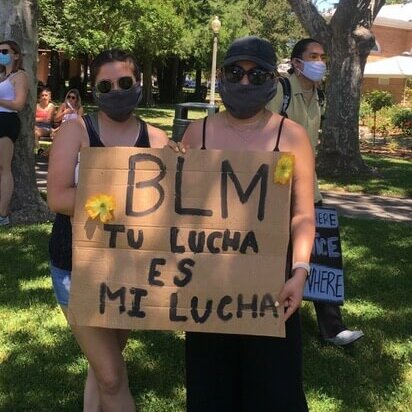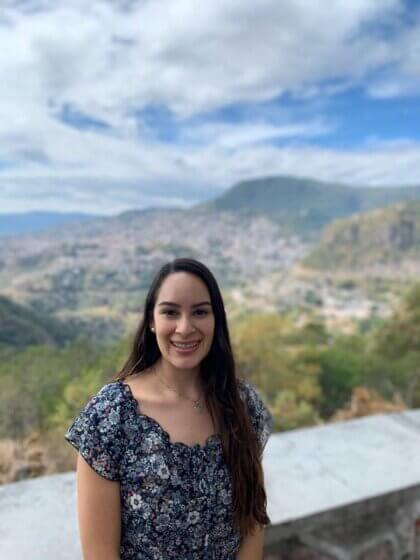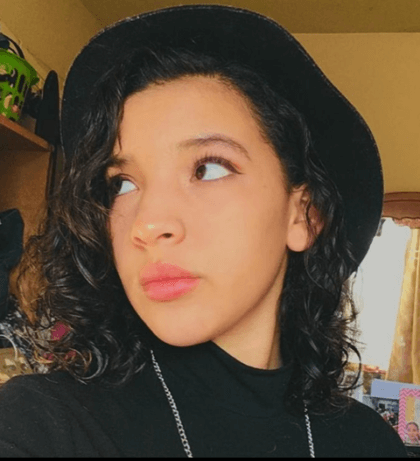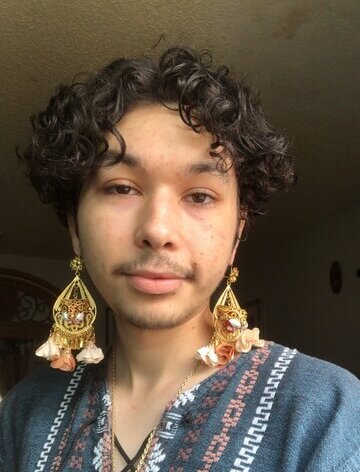Growing toward racial equity in the Sonoma Valley

Sonoma Valley youth of color have been active in the struggle for racial equity. The first step of course is to bring attention to the need. Local youth of color have been shining a light on their experiences of racial injustice in the Valley. Some have found their voice in rallies that followed the murder of George Floyd, others have taken the opportunity provided by the Springs Municipal Advisory Council (SMAC) in August to make themselves heard.
Here we bring you three of many young people who are courageously speaking up about the racial inequity and injustice they experience, and have witnessed.
In the Sonoma Valley, where Latinx are a majority minority, many of the issues raised by the Black Lives Matter movement intersect with injustices felt by Latinx. George Floyd’s and the deaths of many other Black people at the hands of law enforcement, were a raw reminder of the fatal Santa Rosa shooting of 13-year-old Andy López in 2013, by a sheriff’s deputy who has returned to active duty.
As background, remember that when these young people began speaking up in the Valley, the Latinx community was already bearing the brunt of the effects of the pandemic. Comprising 26 percent of the county’s population, Latinx had over 70 percent of the cases in the earlier days of the major spread in Sonoma County, with over 54 percent even now. Add to this the stress of food insecurity and housing insecurity, results of the pandemic that again have hit their community disproportionately. And of course these young people already share the anxiety of their Anglo peers about the climate crisis.
“My father was deported after a routine traffic stop.”

Alondra Bravo Marroquín, 25, is a senior and a McNair Scholar at Sonoma State University, majoring in sociology. She also works at Sonoma Immigration Services. Born in Sonoma, she is the daughter, sister, and wife of Mexican immigrants. She thanks Kate Ortolano who encouraged her to be a board member of Art Escape, and Vicki Handron, the immigration attorney for whom she works.
Alondra recounts going at 13 to the county jail to say good-bye to her father, who was being deported after a routine traffic stop. She was alone; her undocumented family feared going there. This is an excerpt from her lengthy and moving testimonial to the SMAC.
“I was in shock to see my dad handcuffed like a criminal. I had to visit him through a very thick glass window. I remember crying… and I also remember begging the officer to let me give my dad one last hug and being told no. I just dropped to the ground and cried. The next day, my dad was deported with a group of other men – all chained by their hands and feet. They were dropped off to fend for themselves in Tijuana. Sadly, forced family separation is still occurring today. Also, I’d like to point out that we have many immigrants and refugees living in the shadows here in Sonoma Valley who we must recognize and validate.
“When I was attending SVHS, I was told by some teachers to not sign up to Honors or AP courses because it would be too difficult. I did anyway. In Honors English class my sophomore year, I recited a poem about my dad’s deportation. I couldn’t finish because I started sobbing. My English teacher never reached out to me, not even after class.
“In High School, I also joined AVID (Advancement Via Individual Determination). My AVID class was full of people of color. We were not an easy group of students to work with. A lot of us had a lot going on at home. But thanks to our teacher, Danielle Lovejoy, who never failed to believe in us and constantly encouraged us, we all graduated high school and most of us attended college. Ms. Lovejoy was the only teacher who made a positive impact on my life while I was in high school.
“I lived in the Springs for over 20 years. Two years ago, I moved to the City of Sonoma and I’ve experienced more racism there than ever before. I’ve been called racist slurs, I’ve been called a stupid woman, and I’ve even had my dog violently kicked. Both of these incidents were initiated by older white men. And I must say I have it good – I carry around my own privileges… I am light-skinned, I am documented, I speak English fluently and yet I’ve dealt with racism while minding my own business in my own neighborhood. Yet, this does not compare to the life and death experiences that other minorities encounter on the daily – especially those who are black or indigenous.”
“If those in charge will not fix this problem, we will.”

Angelina McGroarty, 17, a junior at SVHS, volunteers at local food banks and participated in Mock Trial. She identifies culturally with Hispanic traditions, says that racially she is Mexican, Black, and Caucasian. She plans to become a lawyer and then a judge. She told the Sun, “I want to help create a world where children and teens don’t have to feel like they have done something wrong by existing. I want to help people feel safe when they walk down the street. I want to help change the world so that BIPOC can do everything, and have all of the opportunities of their Caucasian and light-skinned peers.
This is an excerpt from her speech at Sonoma Plaza at the first Black Lives Matter rally in May.
“Now you may be wondering why we as a community are her; it is because Sonoma is not free from the poison of racism.
“I have been lucky, because despite being black and Latina I have been sheltered from the most overt racism. My first recollection of feeling ‘other’ stuck with me for a long time after it happened. When I was only in first grade I went into Payless with my older sister, 25, who was caring for my twin sister and myself, and my cousins, two of which were black and one white. A visually very diverse group. We were just trying on shoes, when my older sister said we needed to leave. She later explained that with five children with her, she couldn’t afford to get into any form of altercation with a woman who was threatening, who saw us all, different shades of brown, and didn’t like us.
“During middle school one of my teachers was uncomfortably comfortable with her casual racist remarks, and would often refer to her students of color as ‘you people.’ When anyone tried, and many did, to report or address this issue to the school administration, nothing was done. Often these students’ work was used as examples of ‘bad’ work. Now that I am at high school, the subtle and not so subtle racism is not only from some teachers, but from students, who use racial slurs and have become physically violent with students of color. This is what the youth of our community are learning.
“They grow up getting hateful examples by the adults that are supposed to teach us right from wrong. What started out as a weird question when I was a child has turned into an expectation. I expect this type of behavior from my peers and adults in my community. I expect to be uncomfortable in classes with certain teachers and around my peers. If those in charge will not fix this problem, we will. We are here, we will be heard, we will be seen, and we will be silent no longer.
“I am not willing to wait for things to get better by themselves, so I am here with all of you today to make a change, by asking you to change with me. Speak out against casual racism, have honest conversations with your children about hate speech and what you expect of them, but most importantly, vote.”
“The so-called achievement gap is not real.”

José Valdivia, born and raised in Sonoma, is a sophomore at Swarthmore College pursuing Religious Studies and Latin American/Latinx Studies. José, 19, affirms they (preferred pronoun) have received “so much support in affirming their own identity as well as intellectual pursuits.” At SVHS their senior project delved into issues with pedagogy at the high school. They are “immensely grateful for Mr. Devin Daly in the French department. Since my freshman year, he was always on my team and always encouraged my ideas. I found a great teacher but more importantly a great friend. I want to shout out my femme-tor (female mentor) and friend Esperanza who supported my activist work and continually reaffirmed my sexual and gender identities throughout high school.”
José told the Sun, “I identify as Chicanx or Latinx, and it is a big part of my identity as an individual. I think it is especially relevant in the Valley because of how many Latinx live here. It’s another form of representation to show our diverse cultures and our unremitting presence… Latinx identities are diverse, they’re intersectional, they’re written by overlapping histories of slavery, genocide, and (neo)colonialims/imperialism. I’d like to see more represenations of Afro/Latinx, queer and trans, third gender, two-spirit, indigenous folks, centered in Latinx Heritage Month.
“While I was a student at Sonoma High, I remember engaging in constant conversations with peers, teachers, and administrators around the so-called ‘achievement gap.’ I want to note: the achievement gap is not real. The problem isn’t that we need to help ‘low-achieving’ students to conform to a school system that ignores that people learn differently, that multi-modal education benefits some, that our current curriculum is faulty.
“The problem isn’t achievement, and the problem isn’t with our students either. I want to argue that what we suffer from is a ‘pedagogical gap.’ There is a gap between what our teachers are using and how they’re going about their teaching that is constantly pushing Latinx students out of the high school, as well as barring them from entering AP and Honors classes.
“In my opinion, describing the discrepancy between, for example, Latinx vs. White students on standardized testing as an ‘achievement gap,’ frames the problem as the fault of the individual. Here, the problem of language is in avoiding the way that larger systems are at work in this example with standardized testing. What if we reframe the question: How do we get low-achieving students to perform better on a standardized test? What ways can we teach that avoid standardized tests altogether? What forms of assessment can we use to determine student growth? These are obviously big questions and there are limits based on state/federal policies and standards. I guess the bigger problems I want to tackle with the pedagogical gap is how teachers on an individual level can reassess their own curricula and see the hidden teachings that are reflected by the inclusion/exclusion of topics.”



